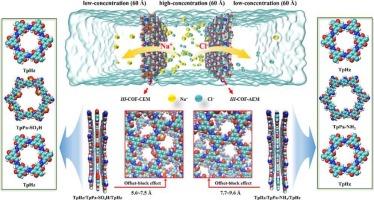用于反电渗析的高效跨膜Na+/Cl−选择性的三明治结构COF膜
IF 9.8
1区 工程技术
Q1 ENGINEERING, CHEMICAL
引用次数: 0
摘要
本研究首次尝试通过反电渗析(RED)技术的分子动力学模拟,研究阳离子和阴离子分别通过夹层结构的共价有机框架(COF)膜(III-COF-CEM和III-COF-AEM)从高浓度储层完全转运到双侧低浓度储层的过程。III-COF-CEM和III-COF-AEM分别采用带负电荷和带正电荷的COF夹层构建,其有效孔径分别为5.6-7.5 Å和7.7-9.6 Å。通过协同尺寸排斥和静电相互作用,膜的Na+/Cl +选择性为94.7,Cl - /Na+选择性为92.1。三明治结构的COF膜可以实现优异的Na+/Cl−的超选择性输运,估计输出功率密度(97.6 W·m−2)可能超过商用膜的基准。这项工作为高效渗透能量收集的高性能膜的开发提供了有价值的见解。本文章由计算机程序翻译,如有差异,请以英文原文为准。

Sandwich-structured COF membranes for efficient transmembrane Na+/Cl− permselectivity of reverse electrodialysis
This study made the first attempt to investigate a complete transport of cations and anions from a high-concentration reservoir to the bilateral low-concentration reservoirs respectively through the sandwich-structured covalent organic framework (COF) membranes (III-COF-CEM and III-COF-AEM) via molecular dynamics simulations for the reverse electrodialysis (RED) technology. The III-COF-CEM and III-COF-AEM were constructed with a negatively-charged and a positively-charged COF interlayers, respectively, which produced the effective pore sizes within the range of 5.6–7.5 Å and 7.7–9.6 Å, respectively. The membranes demonstrated remarkable Na+/Cl− selectivity of 94.7 and Cl−/Na+ selectivity of 92.1 via synergistic size exclusion and electrostatic interactions. The sandwich-structured COF membranes could realize an excellent Na+/Cl− permselective transport, achieving an estimated output power density (97.6 W·m−2) potentially surpassing the benchmark of commercial membranes. This work provides a valuable insight into the development of high-performance membranes for efficient osmotic energy harvesting.
求助全文
通过发布文献求助,成功后即可免费获取论文全文。
去求助
来源期刊

Desalination
工程技术-工程:化工
CiteScore
14.60
自引率
20.20%
发文量
619
审稿时长
41 days
期刊介绍:
Desalination is a scholarly journal that focuses on the field of desalination materials, processes, and associated technologies. It encompasses a wide range of disciplines and aims to publish exceptional papers in this area.
The journal invites submissions that explicitly revolve around water desalting and its applications to various sources such as seawater, groundwater, and wastewater. It particularly encourages research on diverse desalination methods including thermal, membrane, sorption, and hybrid processes.
By providing a platform for innovative studies, Desalination aims to advance the understanding and development of desalination technologies, promoting sustainable solutions for water scarcity challenges.
 求助内容:
求助内容: 应助结果提醒方式:
应助结果提醒方式:


